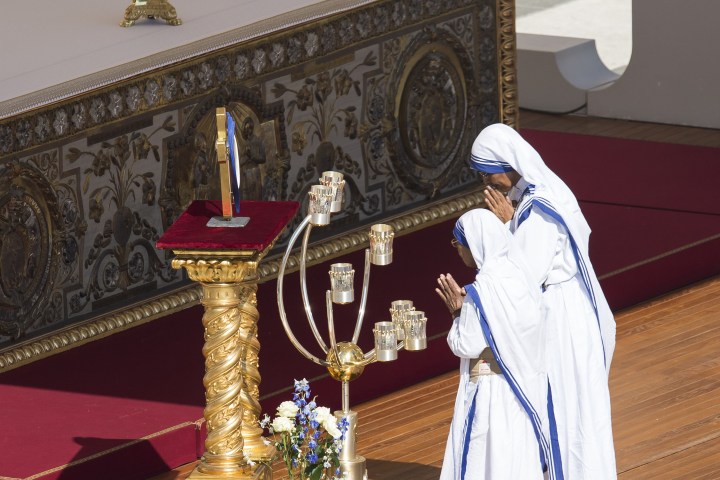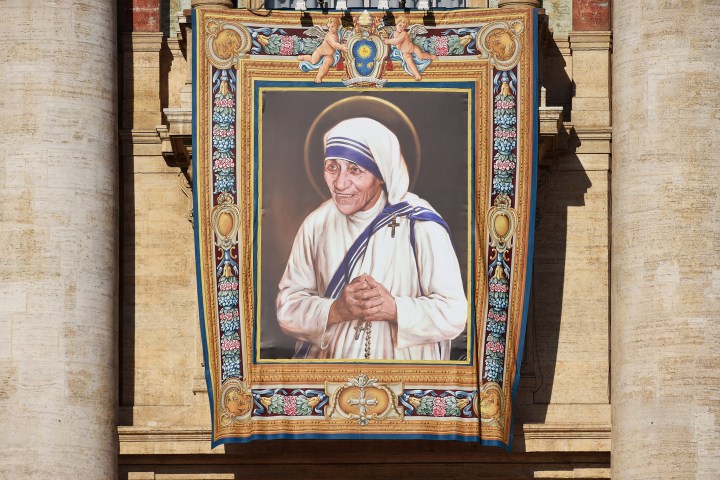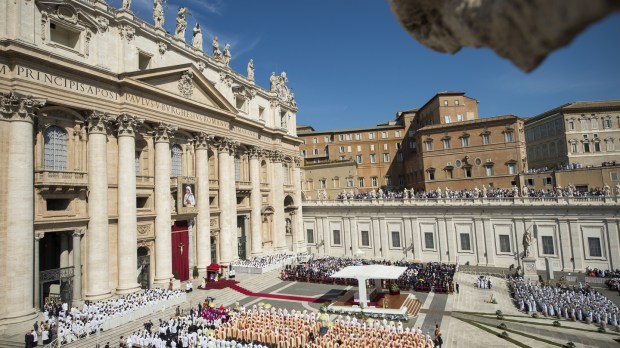At 10:41 a.m., in St. Peter’s Square, the traditional Latin formula was pronounced by Pope Francis: “We declare Blessed Teresa of Calcutta holy and we inscribe her among the saints, decreeing that she be venerated as such by the whole Church.”
Even before the pontiff had finished his sentence, the crowd of some 100,000 pilgrims had begun thunderous applause. Above them, from the facade of the Vatican basilica, the large portrait of Mother Teresa gazed at them with a beautiful smile.
The canonization was followed by a two-hour mass. During the homily, Francis described this little Catholic nun as an “indefatigable artisan of mercy” and as a “figure emblematic of women and consecrated life.”
The crowd applauded loudly when the Pope confided: “I think it will be a bit difficult for us to call her Saint Teresa; her holiness is so close to us, so tender and so fruitful that we will spontaneously continue to say to her: “Mother Teresa.”
“Her mission on the outskirts of cities and in the existential outskirts continues today as an eloquent testimony to the closeness of God to the poor among the poor,” the pontiff affirmed. He concluded by calling on everyone to carry “their smile in their hearts” and to offer it “especially to those who suffer.”

1,500 poor people in places of honor
To reflect Mother Teresa’s commitment to the most marginalized people in society, the Pope also invited around 1,500 homeless and poor people, all cared for by Italian members of Mother Teresa’s order, the Missionaries of Charity.
They attended the celebration in places of honor. After mass, Neapolitan pizzas were offered to them in the Paul VI Room in the Vatican, served by the men and women religious of the congregation founded by the Macedonian sister.
The extraordinary life of Mother Teresa
Agnes Gonxha Bojaxhiu was born in 1910 in Üsküb in the Ottoman Empire—now Skopje, North Macedonia—to Albanian Catholic merchant parents. At 18, she joined the nuns of Our Lady of Loretto in a convent in Ireland, where she took the name Thérèse, in honor of Saint Thérèse of Lisieux.
In 1929, she was sent to Calcutta in India where she pronounced her final vows, and discovered the misery of the working-class neighborhoods. In 1946, she felt a strong call from Christ calling her to put himself at the service of the poor.
She then decided, in 1950, to found the congregation known as the Missionaries of Charity, recognizable by their famous white and blue habits reminiscent of Indian saris. Her congregation is responsible for caring for and supporting the poor and the sick, especially lepers whom no one wants in Calcutta. Her work captured the attention of the world. By 2015, the congregation numbered more than 5,000 men and women religious throughout the world.
After years of suffering from fragile health, Mother Teresa died in Calcutta at the age of 87 in the motherhouse of the Missionaries of Charity on September 5, 1997.

Her short path to holiness
Traditionally, to open a cause for beatification and canonization, the Vatican must wait 5 years after the death of the person in question. In the case of Mother Teresa, Pope John Paul II granted a special dispensation and opened her cause in 1999, just two years after her death.
On October 19, 2003, the Polish Pope declared Mother Teresa “Blessed” after recognizing the miraculous healing of an Indian woman in September 1998. This 30-year-old woman, Monica Besra, had a tumor in her abdomen which disappeared after she was received by the Missionaries of Charity and the nuns placed a medallion that had been blessed by the foundress of their order on the stomach of the patient.
The second miracle which paved the way for canonization was approved by Pope Francis on December 17, 2015. In 2008, a Brazilian man, Marcilio Haddad Andrino, prayed for Mother Teresa’s intercession after discovering that he was affected by several brain tumors. He was supposed to be operated on after his condition deteriorated, but when doctors returned to the operating room, they found him inexplicably cured.





